Exploring Neural Communication in Psychological Neuroscience: Behavior
VerifiedAdded on 2023/06/13
|10
|2622
|104
Essay
AI Summary
This essay delves into the biological basis of human behavior, emphasizing the role of the nervous system and neural communication in cognitive processes. It elucidates how neurons, synapses, and neurotransmitters facilitate communication within the brain, influencing various aspects of behavior. Key brain areas such as the amygdala, hippocampus, Broca's area, and Wernicke's area are discussed in relation to their functions in emotion, memory, and speech. The essay also explores the neural mechanisms underlying learning behavior, including reward learning and social learning, and how memory formation and retrieval are linked to synaptic changes and brain structures like the hippocampus and prefrontal cortex. Furthermore, it addresses the role of spatial attention, regulated by neurotransmitters and cortical regions, and the involvement of Broca's and Wernicke's areas in language processing, ultimately concluding that human behavior arises from the complex interplay of chemical and neural systems within the brain.
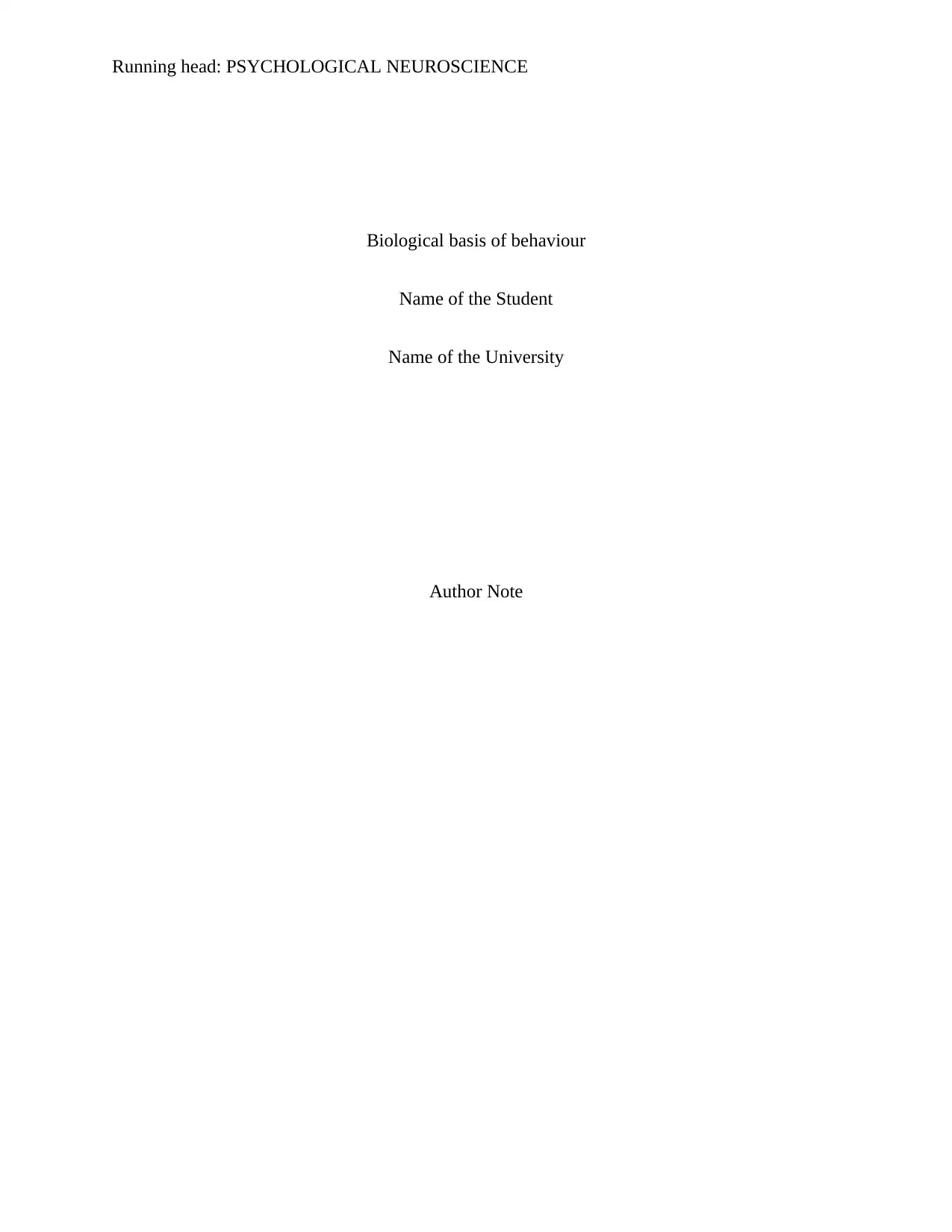
Running head: PSYCHOLOGICAL NEUROSCIENCE
Biological basis of behaviour
Name of the Student
Name of the University
Author Note
Biological basis of behaviour
Name of the Student
Name of the University
Author Note
Paraphrase This Document
Need a fresh take? Get an instant paraphrase of this document with our AI Paraphraser
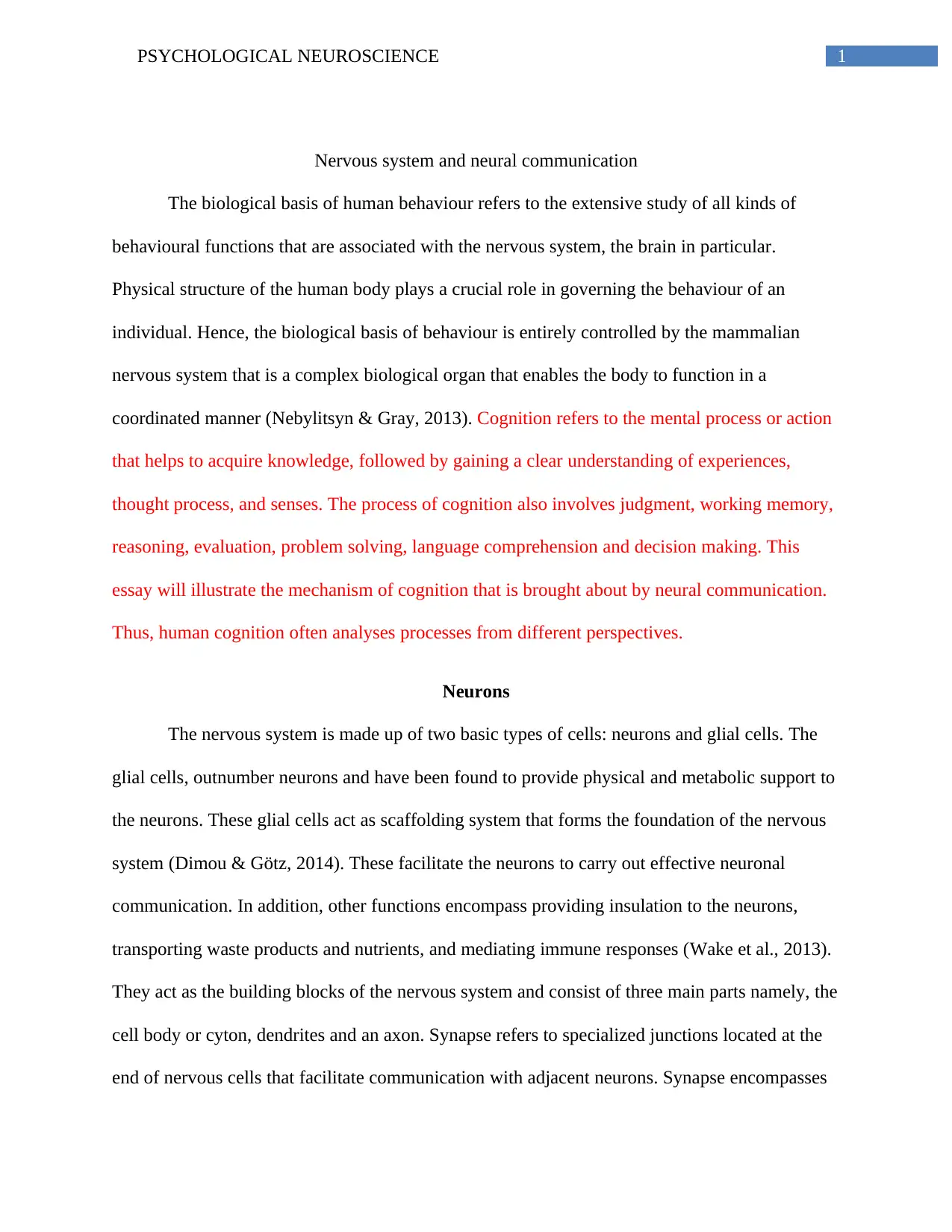
1PSYCHOLOGICAL NEUROSCIENCE
Nervous system and neural communication
The biological basis of human behaviour refers to the extensive study of all kinds of
behavioural functions that are associated with the nervous system, the brain in particular.
Physical structure of the human body plays a crucial role in governing the behaviour of an
individual. Hence, the biological basis of behaviour is entirely controlled by the mammalian
nervous system that is a complex biological organ that enables the body to function in a
coordinated manner (Nebylitsyn & Gray, 2013). Cognition refers to the mental process or action
that helps to acquire knowledge, followed by gaining a clear understanding of experiences,
thought process, and senses. The process of cognition also involves judgment, working memory,
reasoning, evaluation, problem solving, language comprehension and decision making. This
essay will illustrate the mechanism of cognition that is brought about by neural communication.
Thus, human cognition often analyses processes from different perspectives.
Neurons
The nervous system is made up of two basic types of cells: neurons and glial cells. The
glial cells, outnumber neurons and have been found to provide physical and metabolic support to
the neurons. These glial cells act as scaffolding system that forms the foundation of the nervous
system (Dimou & Götz, 2014). These facilitate the neurons to carry out effective neuronal
communication. In addition, other functions encompass providing insulation to the neurons,
transporting waste products and nutrients, and mediating immune responses (Wake et al., 2013).
They act as the building blocks of the nervous system and consist of three main parts namely, the
cell body or cyton, dendrites and an axon. Synapse refers to specialized junctions located at the
end of nervous cells that facilitate communication with adjacent neurons. Synapse encompasses
Nervous system and neural communication
The biological basis of human behaviour refers to the extensive study of all kinds of
behavioural functions that are associated with the nervous system, the brain in particular.
Physical structure of the human body plays a crucial role in governing the behaviour of an
individual. Hence, the biological basis of behaviour is entirely controlled by the mammalian
nervous system that is a complex biological organ that enables the body to function in a
coordinated manner (Nebylitsyn & Gray, 2013). Cognition refers to the mental process or action
that helps to acquire knowledge, followed by gaining a clear understanding of experiences,
thought process, and senses. The process of cognition also involves judgment, working memory,
reasoning, evaluation, problem solving, language comprehension and decision making. This
essay will illustrate the mechanism of cognition that is brought about by neural communication.
Thus, human cognition often analyses processes from different perspectives.
Neurons
The nervous system is made up of two basic types of cells: neurons and glial cells. The
glial cells, outnumber neurons and have been found to provide physical and metabolic support to
the neurons. These glial cells act as scaffolding system that forms the foundation of the nervous
system (Dimou & Götz, 2014). These facilitate the neurons to carry out effective neuronal
communication. In addition, other functions encompass providing insulation to the neurons,
transporting waste products and nutrients, and mediating immune responses (Wake et al., 2013).
They act as the building blocks of the nervous system and consist of three main parts namely, the
cell body or cyton, dendrites and an axon. Synapse refers to specialized junctions located at the
end of nervous cells that facilitate communication with adjacent neurons. Synapse encompasses
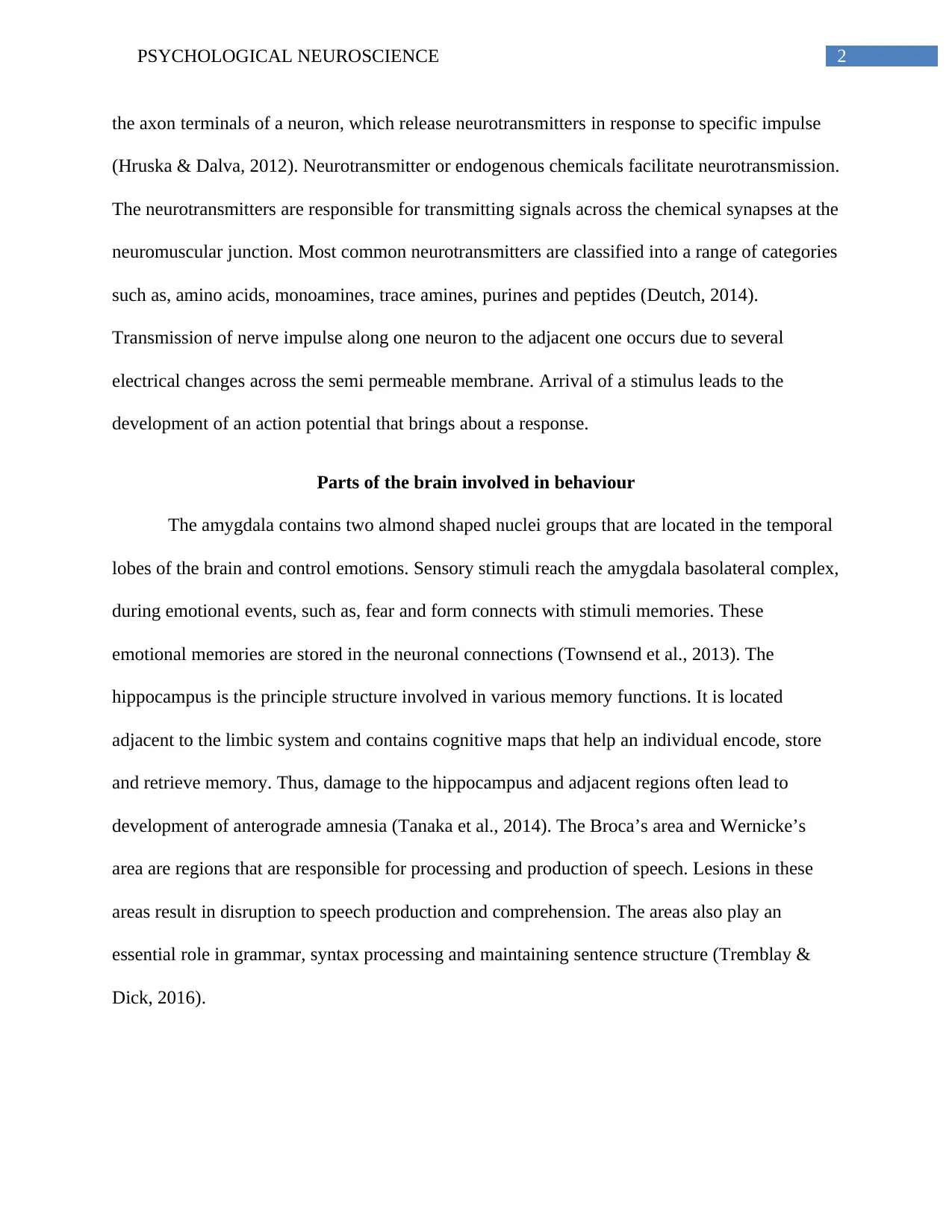
2PSYCHOLOGICAL NEUROSCIENCE
the axon terminals of a neuron, which release neurotransmitters in response to specific impulse
(Hruska & Dalva, 2012). Neurotransmitter or endogenous chemicals facilitate neurotransmission.
The neurotransmitters are responsible for transmitting signals across the chemical synapses at the
neuromuscular junction. Most common neurotransmitters are classified into a range of categories
such as, amino acids, monoamines, trace amines, purines and peptides (Deutch, 2014).
Transmission of nerve impulse along one neuron to the adjacent one occurs due to several
electrical changes across the semi permeable membrane. Arrival of a stimulus leads to the
development of an action potential that brings about a response.
Parts of the brain involved in behaviour
The amygdala contains two almond shaped nuclei groups that are located in the temporal
lobes of the brain and control emotions. Sensory stimuli reach the amygdala basolateral complex,
during emotional events, such as, fear and form connects with stimuli memories. These
emotional memories are stored in the neuronal connections (Townsend et al., 2013). The
hippocampus is the principle structure involved in various memory functions. It is located
adjacent to the limbic system and contains cognitive maps that help an individual encode, store
and retrieve memory. Thus, damage to the hippocampus and adjacent regions often lead to
development of anterograde amnesia (Tanaka et al., 2014). The Broca’s area and Wernicke’s
area are regions that are responsible for processing and production of speech. Lesions in these
areas result in disruption to speech production and comprehension. The areas also play an
essential role in grammar, syntax processing and maintaining sentence structure (Tremblay &
Dick, 2016).
the axon terminals of a neuron, which release neurotransmitters in response to specific impulse
(Hruska & Dalva, 2012). Neurotransmitter or endogenous chemicals facilitate neurotransmission.
The neurotransmitters are responsible for transmitting signals across the chemical synapses at the
neuromuscular junction. Most common neurotransmitters are classified into a range of categories
such as, amino acids, monoamines, trace amines, purines and peptides (Deutch, 2014).
Transmission of nerve impulse along one neuron to the adjacent one occurs due to several
electrical changes across the semi permeable membrane. Arrival of a stimulus leads to the
development of an action potential that brings about a response.
Parts of the brain involved in behaviour
The amygdala contains two almond shaped nuclei groups that are located in the temporal
lobes of the brain and control emotions. Sensory stimuli reach the amygdala basolateral complex,
during emotional events, such as, fear and form connects with stimuli memories. These
emotional memories are stored in the neuronal connections (Townsend et al., 2013). The
hippocampus is the principle structure involved in various memory functions. It is located
adjacent to the limbic system and contains cognitive maps that help an individual encode, store
and retrieve memory. Thus, damage to the hippocampus and adjacent regions often lead to
development of anterograde amnesia (Tanaka et al., 2014). The Broca’s area and Wernicke’s
area are regions that are responsible for processing and production of speech. Lesions in these
areas result in disruption to speech production and comprehension. The areas also play an
essential role in grammar, syntax processing and maintaining sentence structure (Tremblay &
Dick, 2016).
⊘ This is a preview!⊘
Do you want full access?
Subscribe today to unlock all pages.

Trusted by 1+ million students worldwide
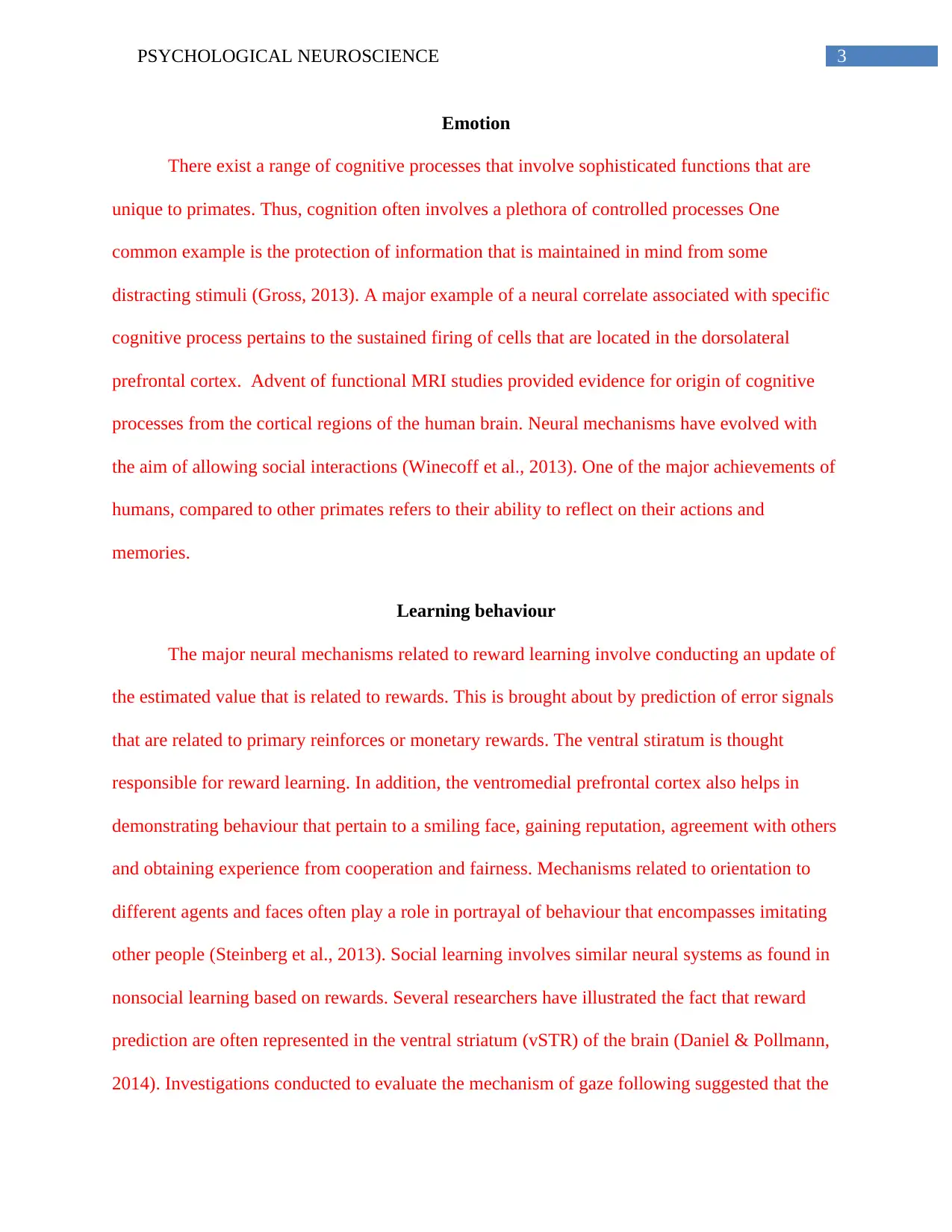
3PSYCHOLOGICAL NEUROSCIENCE
Emotion
There exist a range of cognitive processes that involve sophisticated functions that are
unique to primates. Thus, cognition often involves a plethora of controlled processes One
common example is the protection of information that is maintained in mind from some
distracting stimuli (Gross, 2013). A major example of a neural correlate associated with specific
cognitive process pertains to the sustained firing of cells that are located in the dorsolateral
prefrontal cortex. Advent of functional MRI studies provided evidence for origin of cognitive
processes from the cortical regions of the human brain. Neural mechanisms have evolved with
the aim of allowing social interactions (Winecoff et al., 2013). One of the major achievements of
humans, compared to other primates refers to their ability to reflect on their actions and
memories.
Learning behaviour
The major neural mechanisms related to reward learning involve conducting an update of
the estimated value that is related to rewards. This is brought about by prediction of error signals
that are related to primary reinforces or monetary rewards. The ventral stiratum is thought
responsible for reward learning. In addition, the ventromedial prefrontal cortex also helps in
demonstrating behaviour that pertain to a smiling face, gaining reputation, agreement with others
and obtaining experience from cooperation and fairness. Mechanisms related to orientation to
different agents and faces often play a role in portrayal of behaviour that encompasses imitating
other people (Steinberg et al., 2013). Social learning involves similar neural systems as found in
nonsocial learning based on rewards. Several researchers have illustrated the fact that reward
prediction are often represented in the ventral striatum (vSTR) of the brain (Daniel & Pollmann,
2014). Investigations conducted to evaluate the mechanism of gaze following suggested that the
Emotion
There exist a range of cognitive processes that involve sophisticated functions that are
unique to primates. Thus, cognition often involves a plethora of controlled processes One
common example is the protection of information that is maintained in mind from some
distracting stimuli (Gross, 2013). A major example of a neural correlate associated with specific
cognitive process pertains to the sustained firing of cells that are located in the dorsolateral
prefrontal cortex. Advent of functional MRI studies provided evidence for origin of cognitive
processes from the cortical regions of the human brain. Neural mechanisms have evolved with
the aim of allowing social interactions (Winecoff et al., 2013). One of the major achievements of
humans, compared to other primates refers to their ability to reflect on their actions and
memories.
Learning behaviour
The major neural mechanisms related to reward learning involve conducting an update of
the estimated value that is related to rewards. This is brought about by prediction of error signals
that are related to primary reinforces or monetary rewards. The ventral stiratum is thought
responsible for reward learning. In addition, the ventromedial prefrontal cortex also helps in
demonstrating behaviour that pertain to a smiling face, gaining reputation, agreement with others
and obtaining experience from cooperation and fairness. Mechanisms related to orientation to
different agents and faces often play a role in portrayal of behaviour that encompasses imitating
other people (Steinberg et al., 2013). Social learning involves similar neural systems as found in
nonsocial learning based on rewards. Several researchers have illustrated the fact that reward
prediction are often represented in the ventral striatum (vSTR) of the brain (Daniel & Pollmann,
2014). Investigations conducted to evaluate the mechanism of gaze following suggested that the
Paraphrase This Document
Need a fresh take? Get an instant paraphrase of this document with our AI Paraphraser
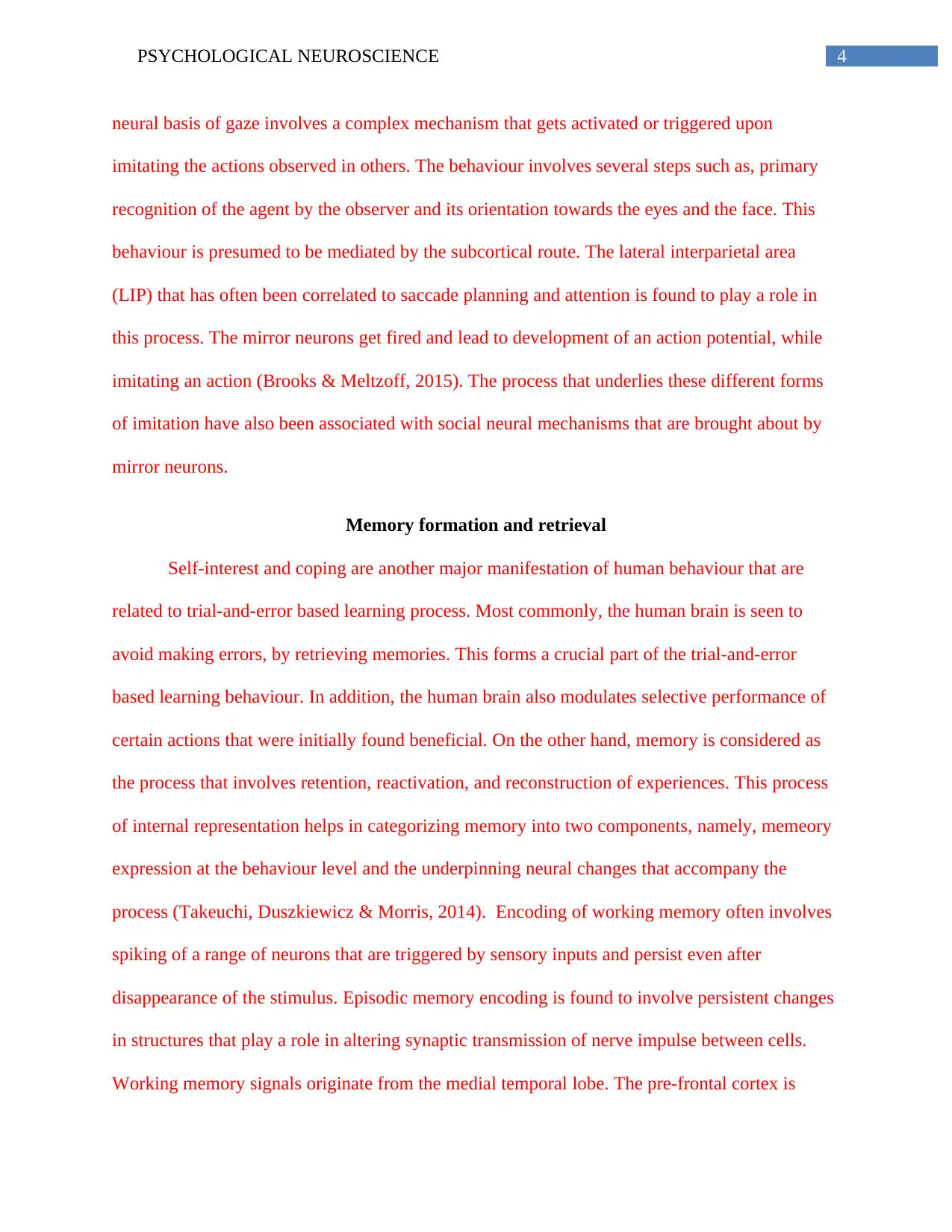
4PSYCHOLOGICAL NEUROSCIENCE
neural basis of gaze involves a complex mechanism that gets activated or triggered upon
imitating the actions observed in others. The behaviour involves several steps such as, primary
recognition of the agent by the observer and its orientation towards the eyes and the face. This
behaviour is presumed to be mediated by the subcortical route. The lateral interparietal area
(LIP) that has often been correlated to saccade planning and attention is found to play a role in
this process. The mirror neurons get fired and lead to development of an action potential, while
imitating an action (Brooks & Meltzoff, 2015). The process that underlies these different forms
of imitation have also been associated with social neural mechanisms that are brought about by
mirror neurons.
Memory formation and retrieval
Self-interest and coping are another major manifestation of human behaviour that are
related to trial-and-error based learning process. Most commonly, the human brain is seen to
avoid making errors, by retrieving memories. This forms a crucial part of the trial-and-error
based learning behaviour. In addition, the human brain also modulates selective performance of
certain actions that were initially found beneficial. On the other hand, memory is considered as
the process that involves retention, reactivation, and reconstruction of experiences. This process
of internal representation helps in categorizing memory into two components, namely, memeory
expression at the behaviour level and the underpinning neural changes that accompany the
process (Takeuchi, Duszkiewicz & Morris, 2014). Encoding of working memory often involves
spiking of a range of neurons that are triggered by sensory inputs and persist even after
disappearance of the stimulus. Episodic memory encoding is found to involve persistent changes
in structures that play a role in altering synaptic transmission of nerve impulse between cells.
Working memory signals originate from the medial temporal lobe. The pre-frontal cortex is
neural basis of gaze involves a complex mechanism that gets activated or triggered upon
imitating the actions observed in others. The behaviour involves several steps such as, primary
recognition of the agent by the observer and its orientation towards the eyes and the face. This
behaviour is presumed to be mediated by the subcortical route. The lateral interparietal area
(LIP) that has often been correlated to saccade planning and attention is found to play a role in
this process. The mirror neurons get fired and lead to development of an action potential, while
imitating an action (Brooks & Meltzoff, 2015). The process that underlies these different forms
of imitation have also been associated with social neural mechanisms that are brought about by
mirror neurons.
Memory formation and retrieval
Self-interest and coping are another major manifestation of human behaviour that are
related to trial-and-error based learning process. Most commonly, the human brain is seen to
avoid making errors, by retrieving memories. This forms a crucial part of the trial-and-error
based learning behaviour. In addition, the human brain also modulates selective performance of
certain actions that were initially found beneficial. On the other hand, memory is considered as
the process that involves retention, reactivation, and reconstruction of experiences. This process
of internal representation helps in categorizing memory into two components, namely, memeory
expression at the behaviour level and the underpinning neural changes that accompany the
process (Takeuchi, Duszkiewicz & Morris, 2014). Encoding of working memory often involves
spiking of a range of neurons that are triggered by sensory inputs and persist even after
disappearance of the stimulus. Episodic memory encoding is found to involve persistent changes
in structures that play a role in altering synaptic transmission of nerve impulse between cells.
Working memory signals originate from the medial temporal lobe. The pre-frontal cortex is
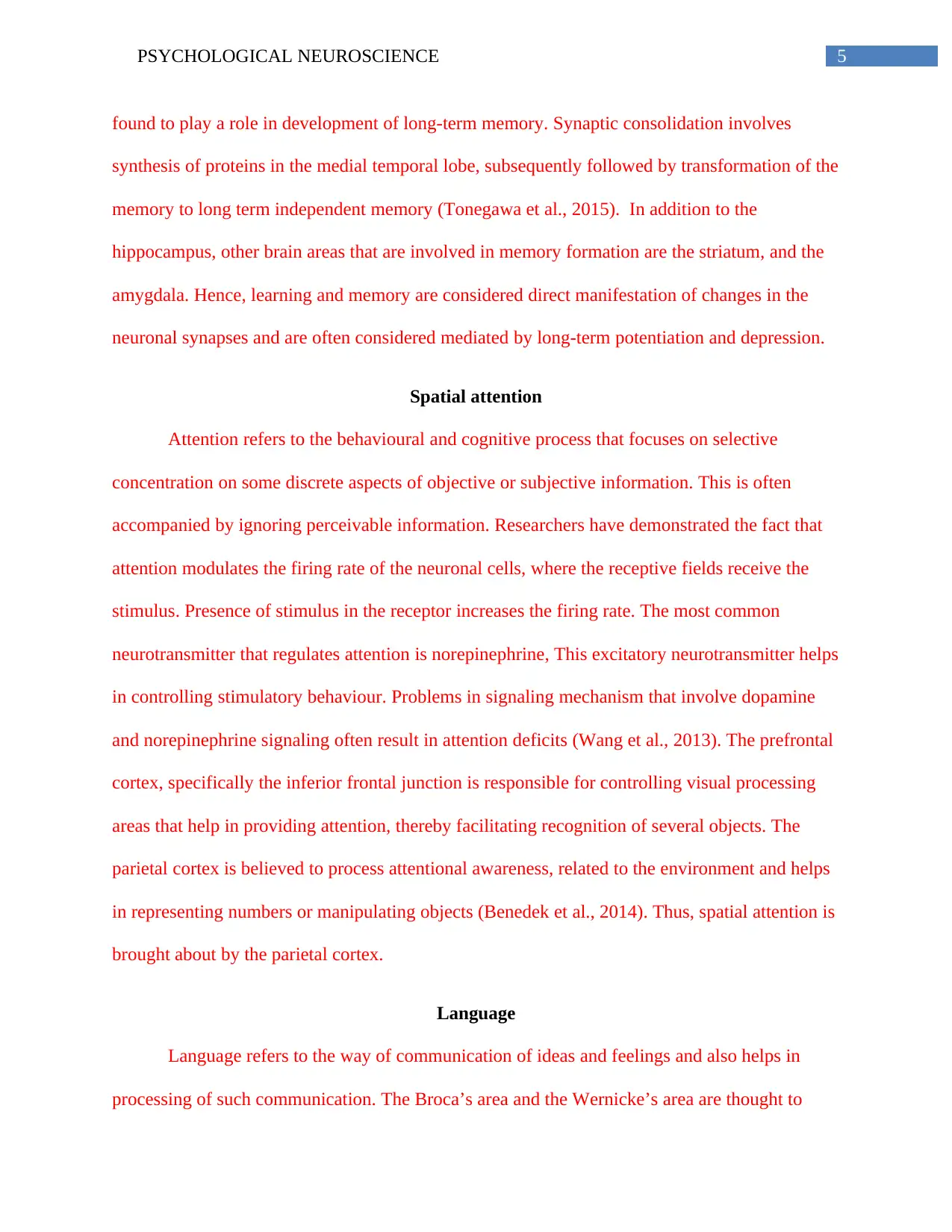
5PSYCHOLOGICAL NEUROSCIENCE
found to play a role in development of long-term memory. Synaptic consolidation involves
synthesis of proteins in the medial temporal lobe, subsequently followed by transformation of the
memory to long term independent memory (Tonegawa et al., 2015). In addition to the
hippocampus, other brain areas that are involved in memory formation are the striatum, and the
amygdala. Hence, learning and memory are considered direct manifestation of changes in the
neuronal synapses and are often considered mediated by long-term potentiation and depression.
Spatial attention
Attention refers to the behavioural and cognitive process that focuses on selective
concentration on some discrete aspects of objective or subjective information. This is often
accompanied by ignoring perceivable information. Researchers have demonstrated the fact that
attention modulates the firing rate of the neuronal cells, where the receptive fields receive the
stimulus. Presence of stimulus in the receptor increases the firing rate. The most common
neurotransmitter that regulates attention is norepinephrine, This excitatory neurotransmitter helps
in controlling stimulatory behaviour. Problems in signaling mechanism that involve dopamine
and norepinephrine signaling often result in attention deficits (Wang et al., 2013). The prefrontal
cortex, specifically the inferior frontal junction is responsible for controlling visual processing
areas that help in providing attention, thereby facilitating recognition of several objects. The
parietal cortex is believed to process attentional awareness, related to the environment and helps
in representing numbers or manipulating objects (Benedek et al., 2014). Thus, spatial attention is
brought about by the parietal cortex.
Language
Language refers to the way of communication of ideas and feelings and also helps in
processing of such communication. The Broca’s area and the Wernicke’s area are thought to
found to play a role in development of long-term memory. Synaptic consolidation involves
synthesis of proteins in the medial temporal lobe, subsequently followed by transformation of the
memory to long term independent memory (Tonegawa et al., 2015). In addition to the
hippocampus, other brain areas that are involved in memory formation are the striatum, and the
amygdala. Hence, learning and memory are considered direct manifestation of changes in the
neuronal synapses and are often considered mediated by long-term potentiation and depression.
Spatial attention
Attention refers to the behavioural and cognitive process that focuses on selective
concentration on some discrete aspects of objective or subjective information. This is often
accompanied by ignoring perceivable information. Researchers have demonstrated the fact that
attention modulates the firing rate of the neuronal cells, where the receptive fields receive the
stimulus. Presence of stimulus in the receptor increases the firing rate. The most common
neurotransmitter that regulates attention is norepinephrine, This excitatory neurotransmitter helps
in controlling stimulatory behaviour. Problems in signaling mechanism that involve dopamine
and norepinephrine signaling often result in attention deficits (Wang et al., 2013). The prefrontal
cortex, specifically the inferior frontal junction is responsible for controlling visual processing
areas that help in providing attention, thereby facilitating recognition of several objects. The
parietal cortex is believed to process attentional awareness, related to the environment and helps
in representing numbers or manipulating objects (Benedek et al., 2014). Thus, spatial attention is
brought about by the parietal cortex.
Language
Language refers to the way of communication of ideas and feelings and also helps in
processing of such communication. The Broca’s area and the Wernicke’s area are thought to
⊘ This is a preview!⊘
Do you want full access?
Subscribe today to unlock all pages.

Trusted by 1+ million students worldwide
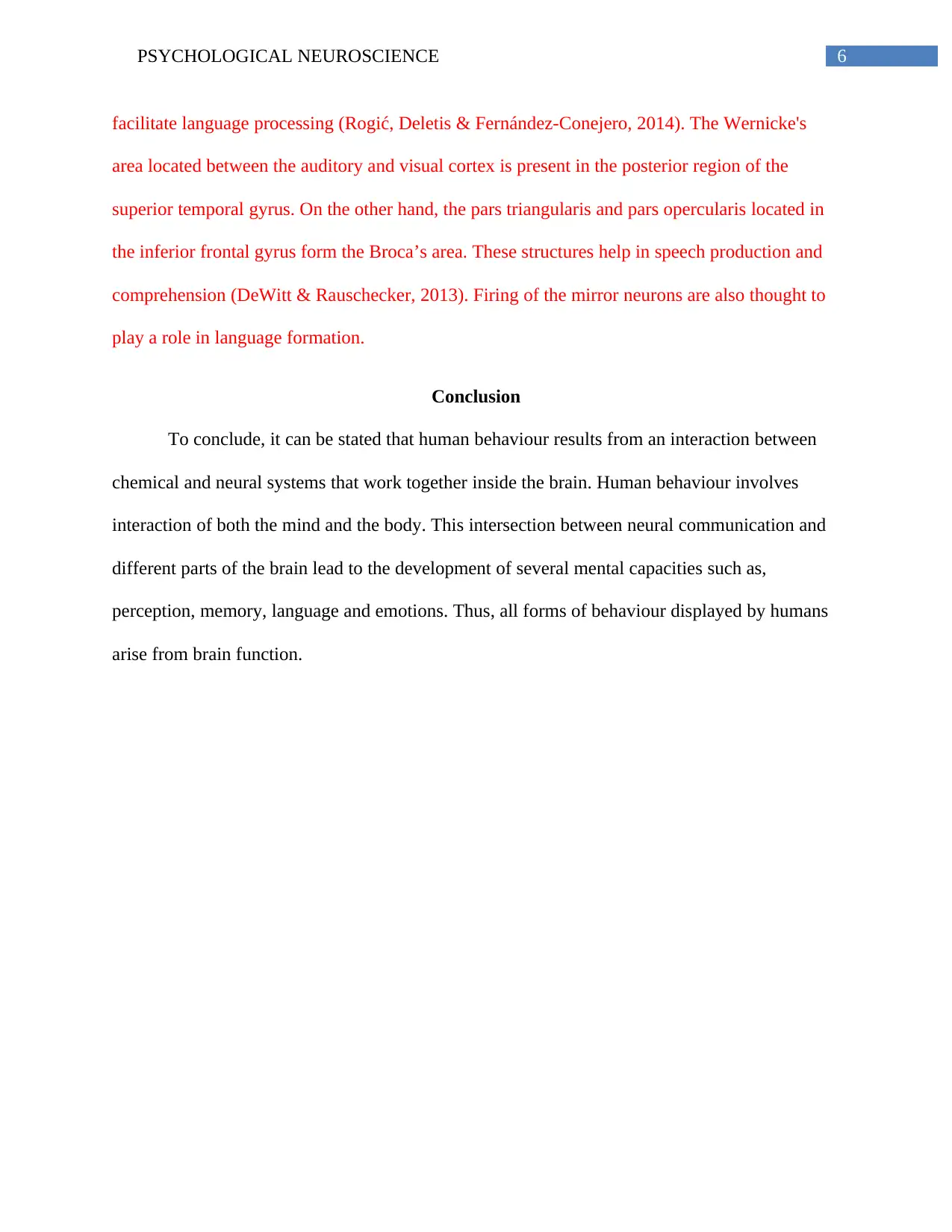
6PSYCHOLOGICAL NEUROSCIENCE
facilitate language processing (Rogić, Deletis & Fernández-Conejero, 2014). The Wernicke's
area located between the auditory and visual cortex is present in the posterior region of the
superior temporal gyrus. On the other hand, the pars triangularis and pars opercularis located in
the inferior frontal gyrus form the Broca’s area. These structures help in speech production and
comprehension (DeWitt & Rauschecker, 2013). Firing of the mirror neurons are also thought to
play a role in language formation.
Conclusion
To conclude, it can be stated that human behaviour results from an interaction between
chemical and neural systems that work together inside the brain. Human behaviour involves
interaction of both the mind and the body. This intersection between neural communication and
different parts of the brain lead to the development of several mental capacities such as,
perception, memory, language and emotions. Thus, all forms of behaviour displayed by humans
arise from brain function.
facilitate language processing (Rogić, Deletis & Fernández-Conejero, 2014). The Wernicke's
area located between the auditory and visual cortex is present in the posterior region of the
superior temporal gyrus. On the other hand, the pars triangularis and pars opercularis located in
the inferior frontal gyrus form the Broca’s area. These structures help in speech production and
comprehension (DeWitt & Rauschecker, 2013). Firing of the mirror neurons are also thought to
play a role in language formation.
Conclusion
To conclude, it can be stated that human behaviour results from an interaction between
chemical and neural systems that work together inside the brain. Human behaviour involves
interaction of both the mind and the body. This intersection between neural communication and
different parts of the brain lead to the development of several mental capacities such as,
perception, memory, language and emotions. Thus, all forms of behaviour displayed by humans
arise from brain function.
Paraphrase This Document
Need a fresh take? Get an instant paraphrase of this document with our AI Paraphraser
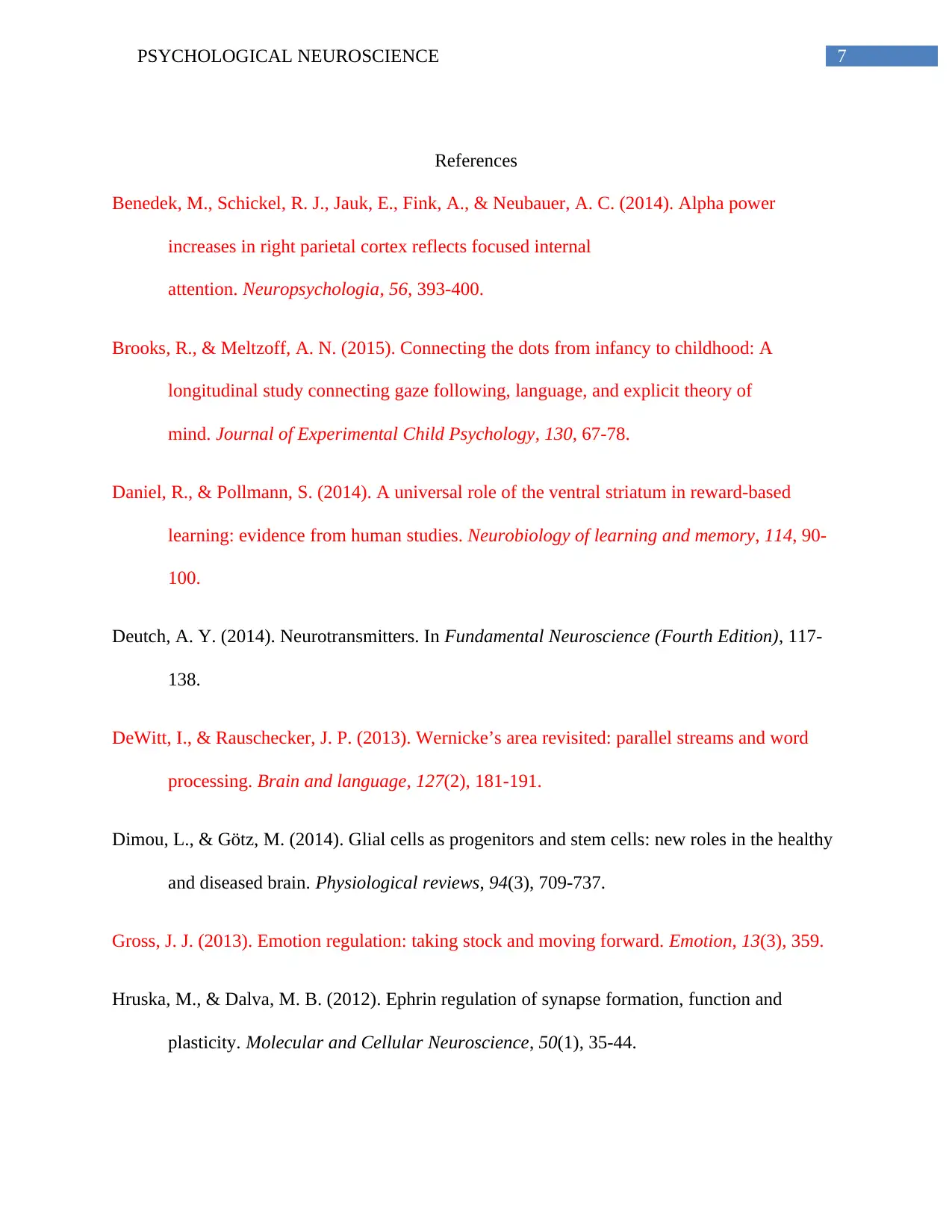
7PSYCHOLOGICAL NEUROSCIENCE
References
Benedek, M., Schickel, R. J., Jauk, E., Fink, A., & Neubauer, A. C. (2014). Alpha power
increases in right parietal cortex reflects focused internal
attention. Neuropsychologia, 56, 393-400.
Brooks, R., & Meltzoff, A. N. (2015). Connecting the dots from infancy to childhood: A
longitudinal study connecting gaze following, language, and explicit theory of
mind. Journal of Experimental Child Psychology, 130, 67-78.
Daniel, R., & Pollmann, S. (2014). A universal role of the ventral striatum in reward-based
learning: evidence from human studies. Neurobiology of learning and memory, 114, 90-
100.
Deutch, A. Y. (2014). Neurotransmitters. In Fundamental Neuroscience (Fourth Edition), 117-
138.
DeWitt, I., & Rauschecker, J. P. (2013). Wernicke’s area revisited: parallel streams and word
processing. Brain and language, 127(2), 181-191.
Dimou, L., & Götz, M. (2014). Glial cells as progenitors and stem cells: new roles in the healthy
and diseased brain. Physiological reviews, 94(3), 709-737.
Gross, J. J. (2013). Emotion regulation: taking stock and moving forward. Emotion, 13(3), 359.
Hruska, M., & Dalva, M. B. (2012). Ephrin regulation of synapse formation, function and
plasticity. Molecular and Cellular Neuroscience, 50(1), 35-44.
References
Benedek, M., Schickel, R. J., Jauk, E., Fink, A., & Neubauer, A. C. (2014). Alpha power
increases in right parietal cortex reflects focused internal
attention. Neuropsychologia, 56, 393-400.
Brooks, R., & Meltzoff, A. N. (2015). Connecting the dots from infancy to childhood: A
longitudinal study connecting gaze following, language, and explicit theory of
mind. Journal of Experimental Child Psychology, 130, 67-78.
Daniel, R., & Pollmann, S. (2014). A universal role of the ventral striatum in reward-based
learning: evidence from human studies. Neurobiology of learning and memory, 114, 90-
100.
Deutch, A. Y. (2014). Neurotransmitters. In Fundamental Neuroscience (Fourth Edition), 117-
138.
DeWitt, I., & Rauschecker, J. P. (2013). Wernicke’s area revisited: parallel streams and word
processing. Brain and language, 127(2), 181-191.
Dimou, L., & Götz, M. (2014). Glial cells as progenitors and stem cells: new roles in the healthy
and diseased brain. Physiological reviews, 94(3), 709-737.
Gross, J. J. (2013). Emotion regulation: taking stock and moving forward. Emotion, 13(3), 359.
Hruska, M., & Dalva, M. B. (2012). Ephrin regulation of synapse formation, function and
plasticity. Molecular and Cellular Neuroscience, 50(1), 35-44.
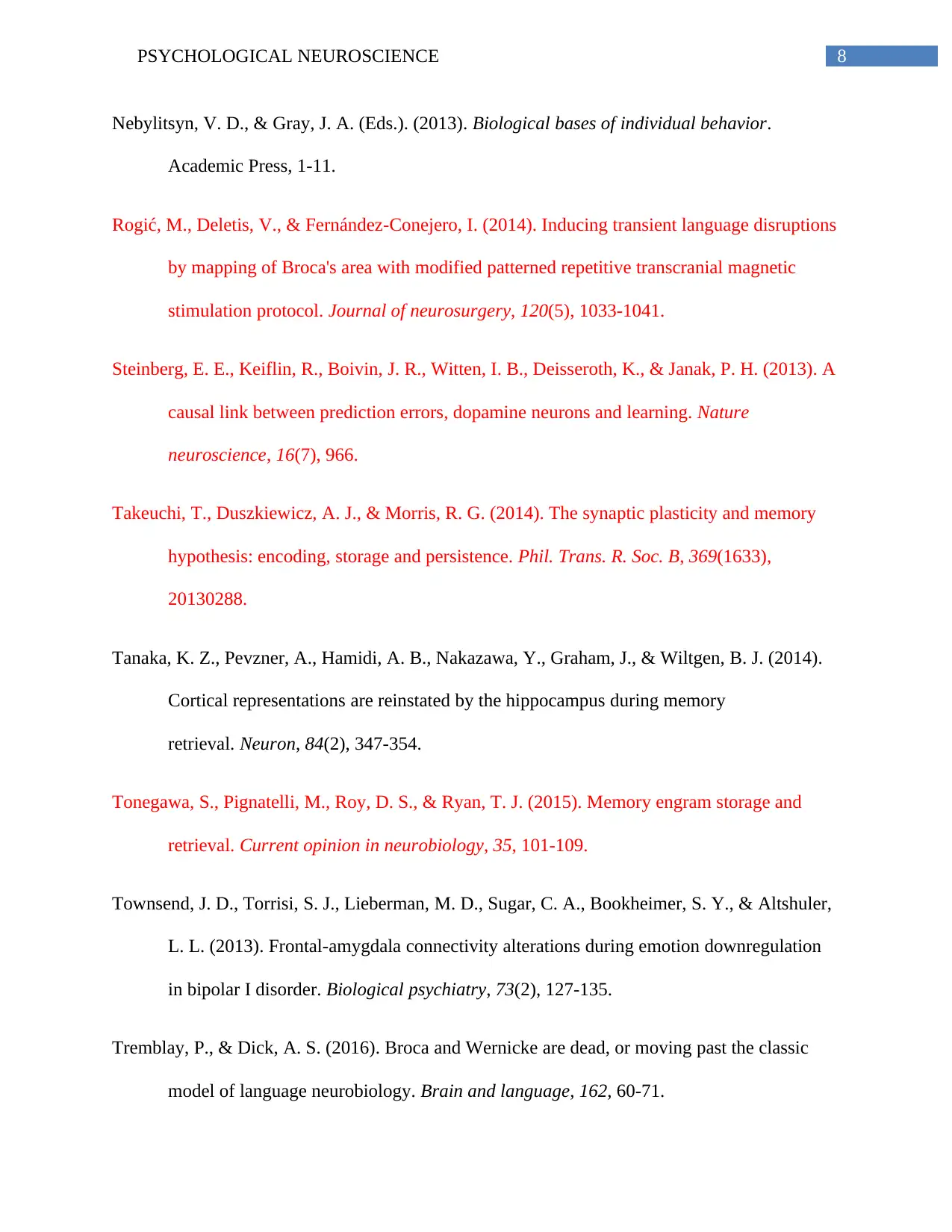
8PSYCHOLOGICAL NEUROSCIENCE
Nebylitsyn, V. D., & Gray, J. A. (Eds.). (2013). Biological bases of individual behavior.
Academic Press, 1-11.
Rogić, M., Deletis, V., & Fernández-Conejero, I. (2014). Inducing transient language disruptions
by mapping of Broca's area with modified patterned repetitive transcranial magnetic
stimulation protocol. Journal of neurosurgery, 120(5), 1033-1041.
Steinberg, E. E., Keiflin, R., Boivin, J. R., Witten, I. B., Deisseroth, K., & Janak, P. H. (2013). A
causal link between prediction errors, dopamine neurons and learning. Nature
neuroscience, 16(7), 966.
Takeuchi, T., Duszkiewicz, A. J., & Morris, R. G. (2014). The synaptic plasticity and memory
hypothesis: encoding, storage and persistence. Phil. Trans. R. Soc. B, 369(1633),
20130288.
Tanaka, K. Z., Pevzner, A., Hamidi, A. B., Nakazawa, Y., Graham, J., & Wiltgen, B. J. (2014).
Cortical representations are reinstated by the hippocampus during memory
retrieval. Neuron, 84(2), 347-354.
Tonegawa, S., Pignatelli, M., Roy, D. S., & Ryan, T. J. (2015). Memory engram storage and
retrieval. Current opinion in neurobiology, 35, 101-109.
Townsend, J. D., Torrisi, S. J., Lieberman, M. D., Sugar, C. A., Bookheimer, S. Y., & Altshuler,
L. L. (2013). Frontal-amygdala connectivity alterations during emotion downregulation
in bipolar I disorder. Biological psychiatry, 73(2), 127-135.
Tremblay, P., & Dick, A. S. (2016). Broca and Wernicke are dead, or moving past the classic
model of language neurobiology. Brain and language, 162, 60-71.
Nebylitsyn, V. D., & Gray, J. A. (Eds.). (2013). Biological bases of individual behavior.
Academic Press, 1-11.
Rogić, M., Deletis, V., & Fernández-Conejero, I. (2014). Inducing transient language disruptions
by mapping of Broca's area with modified patterned repetitive transcranial magnetic
stimulation protocol. Journal of neurosurgery, 120(5), 1033-1041.
Steinberg, E. E., Keiflin, R., Boivin, J. R., Witten, I. B., Deisseroth, K., & Janak, P. H. (2013). A
causal link between prediction errors, dopamine neurons and learning. Nature
neuroscience, 16(7), 966.
Takeuchi, T., Duszkiewicz, A. J., & Morris, R. G. (2014). The synaptic plasticity and memory
hypothesis: encoding, storage and persistence. Phil. Trans. R. Soc. B, 369(1633),
20130288.
Tanaka, K. Z., Pevzner, A., Hamidi, A. B., Nakazawa, Y., Graham, J., & Wiltgen, B. J. (2014).
Cortical representations are reinstated by the hippocampus during memory
retrieval. Neuron, 84(2), 347-354.
Tonegawa, S., Pignatelli, M., Roy, D. S., & Ryan, T. J. (2015). Memory engram storage and
retrieval. Current opinion in neurobiology, 35, 101-109.
Townsend, J. D., Torrisi, S. J., Lieberman, M. D., Sugar, C. A., Bookheimer, S. Y., & Altshuler,
L. L. (2013). Frontal-amygdala connectivity alterations during emotion downregulation
in bipolar I disorder. Biological psychiatry, 73(2), 127-135.
Tremblay, P., & Dick, A. S. (2016). Broca and Wernicke are dead, or moving past the classic
model of language neurobiology. Brain and language, 162, 60-71.
⊘ This is a preview!⊘
Do you want full access?
Subscribe today to unlock all pages.

Trusted by 1+ million students worldwide
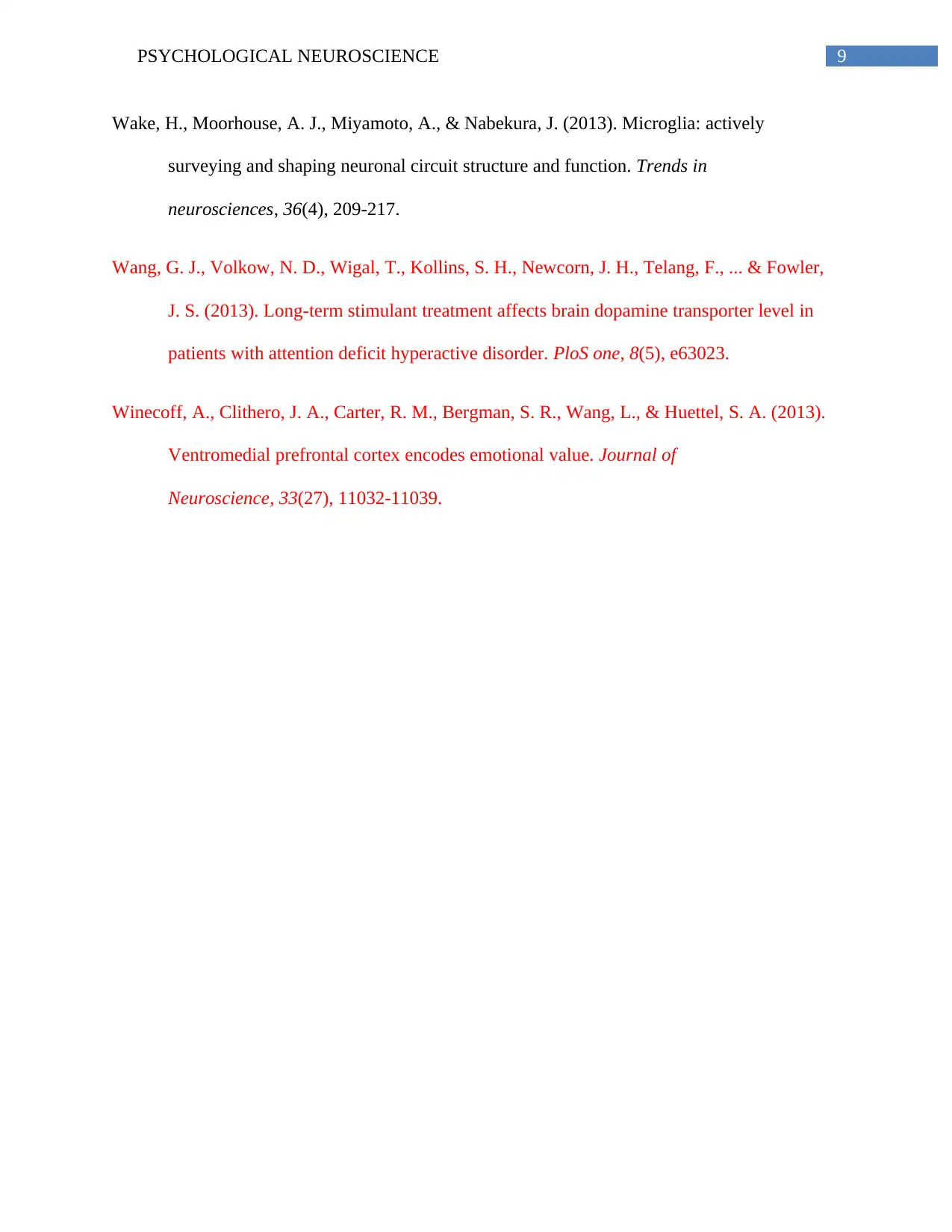
9PSYCHOLOGICAL NEUROSCIENCE
Wake, H., Moorhouse, A. J., Miyamoto, A., & Nabekura, J. (2013). Microglia: actively
surveying and shaping neuronal circuit structure and function. Trends in
neurosciences, 36(4), 209-217.
Wang, G. J., Volkow, N. D., Wigal, T., Kollins, S. H., Newcorn, J. H., Telang, F., ... & Fowler,
J. S. (2013). Long-term stimulant treatment affects brain dopamine transporter level in
patients with attention deficit hyperactive disorder. PloS one, 8(5), e63023.
Winecoff, A., Clithero, J. A., Carter, R. M., Bergman, S. R., Wang, L., & Huettel, S. A. (2013).
Ventromedial prefrontal cortex encodes emotional value. Journal of
Neuroscience, 33(27), 11032-11039.
Wake, H., Moorhouse, A. J., Miyamoto, A., & Nabekura, J. (2013). Microglia: actively
surveying and shaping neuronal circuit structure and function. Trends in
neurosciences, 36(4), 209-217.
Wang, G. J., Volkow, N. D., Wigal, T., Kollins, S. H., Newcorn, J. H., Telang, F., ... & Fowler,
J. S. (2013). Long-term stimulant treatment affects brain dopamine transporter level in
patients with attention deficit hyperactive disorder. PloS one, 8(5), e63023.
Winecoff, A., Clithero, J. A., Carter, R. M., Bergman, S. R., Wang, L., & Huettel, S. A. (2013).
Ventromedial prefrontal cortex encodes emotional value. Journal of
Neuroscience, 33(27), 11032-11039.
1 out of 10
Related Documents
Your All-in-One AI-Powered Toolkit for Academic Success.
+13062052269
info@desklib.com
Available 24*7 on WhatsApp / Email
![[object Object]](/_next/static/media/star-bottom.7253800d.svg)
Unlock your academic potential
Copyright © 2020–2025 A2Z Services. All Rights Reserved. Developed and managed by ZUCOL.





